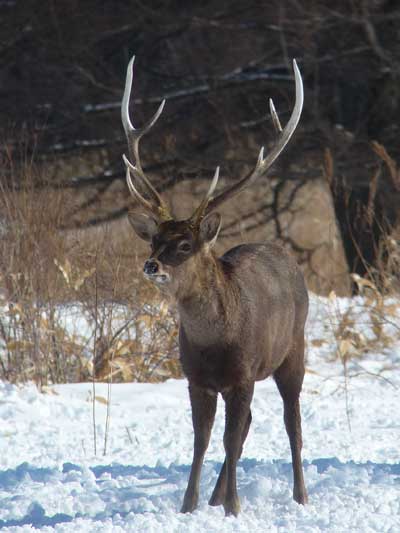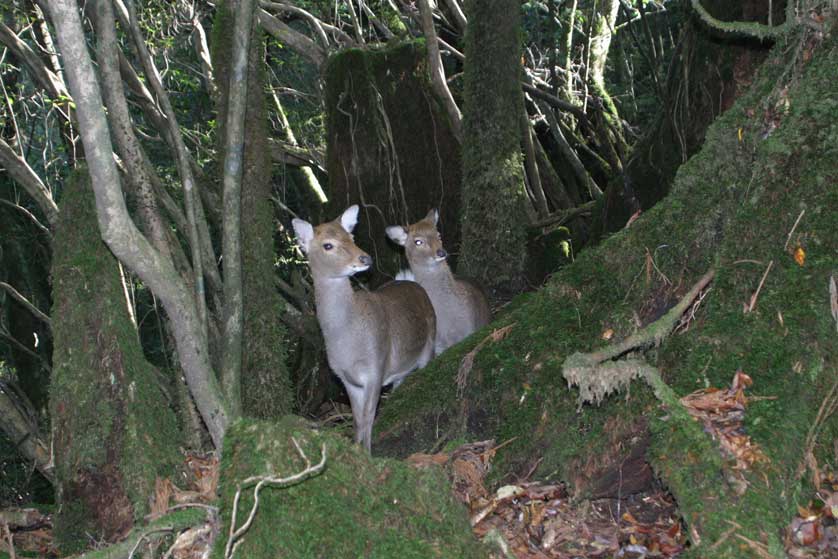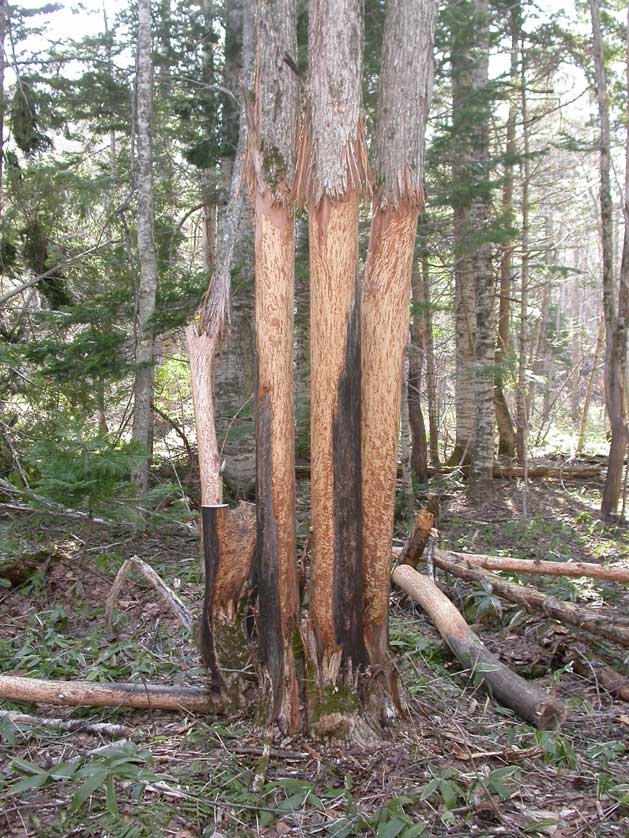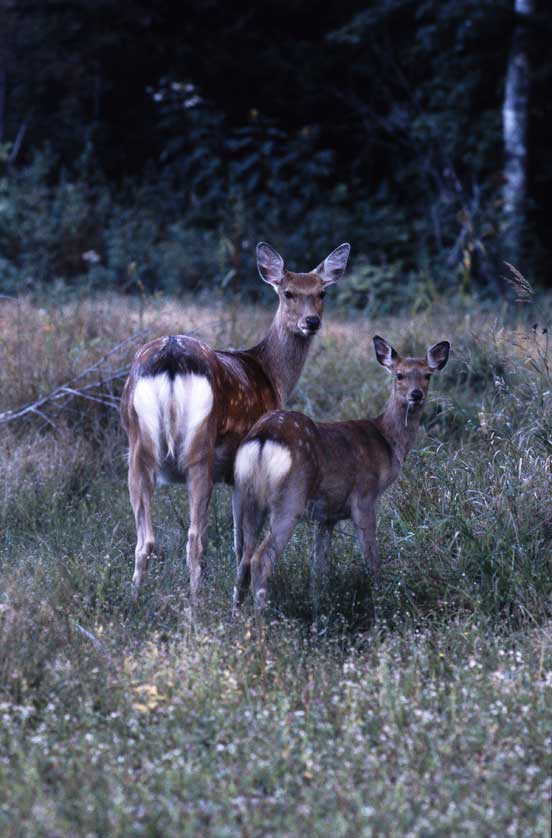The sika deer : A fascinating species native to East Asia
- Published on : 28/03/2024
- by : Japan Experience
- Youtube
Physical characteristics and appearance of sika deer
Sika deer have a reddish-brown coat with prominent white spots during summer, which helps provide camouflage in the dappled light of the forest understory. In winter, their coat transitions to a darker brown or grey color, with the spots becoming less noticeable. Males, known as stags, develop a dark shaggy mane along their necks during the winter months. Sika deer have a white rump patch with a black border on top, and a white tail with a black stripe running down the center.
Males grow antlers annually, typically having 4 points as mature stags but occasionally up to 8 points. Antlers are narrow and swept back, rather than forward like those of the Japanese macaque. Sika are a medium-sized deer, with stags standing 70-95 cm at the shoulder and weighing 40-70 kg, while hinds are 50-70 cm tall and weigh 30-45 kg. The largest subspecies is the Manchurian sika of mainland Asia, with the smallest being the Japanese sika of southern Japan.
Subspecies and their geographic distribution
There are 6-14 subspecies of sika deer recognized, depending on the taxonomic authority. Key subspecies include the Japanese sika (C. n. nippon) found in southern Japan, the Formosan sika (C. n. taiouanus) native to Taiwan, and the Manchurian sika (C. n. mantchuricus) of mainland Asia. Most of the introduced populations around the world originated from the Japanese subspecies.
In their native range, sika deer populations have declined significantly due to hunting, habitat loss, and competition with introduced deer species and livestock. However, they remain very abundant in Japan due to a lack of natural predators and strict hunting regulations. Sika deer have also thrived in many of the areas where they have been introduced.

Behavior and social structure
Sika deer are generally crepuscular, being most active at dawn and dusk. Outside the breeding season, males and females typically remain segregated. Stags are often solitary or form loose bachelor groups, while hinds live in small family groups with their young. Sika are known to be very vocal, with a repertoire of at least 10 different vocalizations. Stags make a distinctive whistling sound during the rut, which is sometimes called a "bugle."
Sika are primarily browsers, feeding on a variety of grasses, forbs, leaves, and twigs. They will also eagerly eat agricultural crops, leading to conflicts with farmers in some areas. Sika are excellent swimmers and readily take to the water to evade predators or access islands. When alarmed, they will raise their tail and rump patch, emitting a barking alarm call.
Habitat preferences and population status
The preferred habitat of sika deer is forested areas with dense understory, typically in temperate to subtropical regions. In their introduced range, they have also adapted well to open grasslands and even marshlands. Sika deer thrive in areas with low annual snowfall, as heavy snow can limit their ability to find food.
In Japan, sika deer populations have exploded in recent decades, leading to significant impacts on native forests through overbrowsing. In other parts of their native range, such as China and Korea, sika deer are considered threatened by hunting and habitat loss. The status of introduced populations varies, with some being valued as a hunting resource while others are seen as a potentially invasive species.
Introduced populations around the world
Sika deer have been introduced to numerous countries around the world, often as ornamental animals in parks and estates. These introductions include:
- Europe: Austria, Belgium, Czech Republic, Denmark, Finland, France, Germany, Ireland, Lithuania, Netherlands, Norway, Poland, Russia, Sweden, Switzerland, United Kingdom
- North America: Canada, United States (Colorado, Kansas, Maryland, Michigan, Minnesota, Missouri, Nebraska, New York, North Carolina, Oklahoma, Pennsylvania, Texas, Virginia, Washington)
- Oceania: Australia, New Zealand
- Elsewhere: Brazil, South Africa
In some cases, sika deer have had negative impacts as an invasive species. They can alter native plant communities through their browsing, compete with native deer species, and damage forestry plantations and agricultural crops. In the UK, sika deer also hybridize with native red deer, leading to concerns about the genetic integrity of the native species.

Hunting and other human interactions with sika deer
Sika deer are a popular game species in both their native and introduced ranges. In Japan, regulated hunting helps control overabundant populations and provides economic benefits through venison and tourism. In Europe and North America, sika are prized by hunters for their elusive nature and the challenge they present. Many trophy hunters seek out the Manchurian subspecies for their impressive antlers.
However, sika deer can also come into conflict with human interests, particularly in areas where they have been introduced. Their browsing can cause significant damage to forestry plantations and their grazing can reduce crop yields. In addition, sika deer carry ticks that transmit diseases like Lyme disease, posing a human health risk.
Despite these challenges, sika deer have also become an important part of the eco-tourism industry in places like the Scottish Highlands and Nara, Japan. In Nara Park, sika deer are considered sacred messengers of the gods and are protected. Tourists can purchase special crackers to feed the deer, which have become remarkably tame.

Cultural significance of sika deer, especially in Japan
In Japan, sika deer have a long history of cultural significance. In Shinto, the native religion of Japan, sika deer are considered sacred and thought to be messengers of the gods. At Nara Park, home to the Todaiji Temple and Kasuga Shrine, over 1200 sika deer freely roam the grounds and are protected as national treasures.
According to legend, a mythical god arrived in Nara riding on a white deer, leading to deer being considered sacred animals. Until the 1600s, killing one of these sacred deer was punishable by death. Today, the deer are no longer considered sacred, but are still protected and revered. Every summer, a ceremony is held at Kasuga Shrine to honor the sacred deer.
Sika deer have also been a popular subject in Japanese art for centuries. They frequently appear in traditional ukiyo-e woodblock prints and paintings, often depicted as noble creatures alongside cherry blossoms or maple leaves, symbols of the changing seasons. The strength and gracefulness of sika deer stags in particular have long been celebrated in Japanese culture.
In contrast to many western cultures which view deer primarily as game animals, the Japanese have a deep cultural reverence for sika deer rooted in their religious beliefs and artistic traditions. This has led to a different approach to deer management, with the focus being more on population control and damage mitigation rather than sport hunting, though regulated hunting does occur outside of protected areas.
The sika deer remains both an ecologically and culturally important species in Japan. And with the spread of this adaptable deer to new parts of the world, it is developing new cultural associations while continuing to shape landscapes and ecosystems far from its ancestral home in the Japanese archipelago. To learn more about sika deer and the natural history of Japan, check out JapanVisitor's Nature Guide and pick up one of the recommended books on Japanese nature. For a chance to see sika deer in the wild, consider joining a tour with an experienced local nature guide, such as those found at www.japannatureguides.com

The sika deer (Cervus nippon) is a captivating species native to much of East Asia, including Japan, Taiwan, eastern China, Korea, and parts of Russia. While their native range has contracted, sika deer have been introduced to many other parts of the world, such as Europe, Australia, New Zealand, and the United States. These medium-sized deer are known for their distinctive spotted coat that persists into adulthood, unlike many other deer species. Sika deer also exhibit remarkable variation in size between subspecies and noticeable sexual dimorphism, with males being larger than females.









